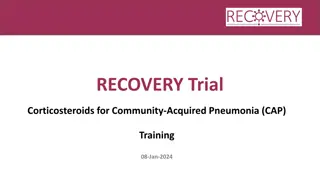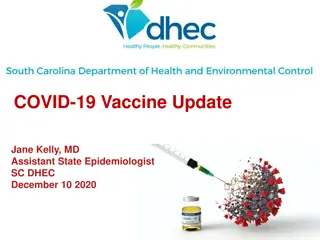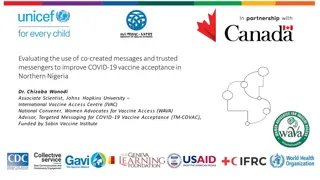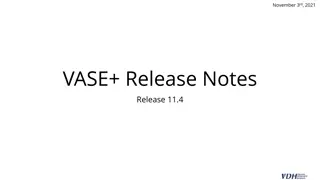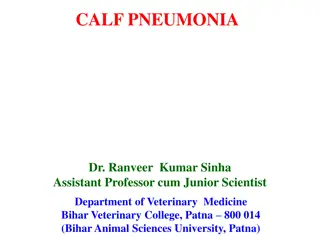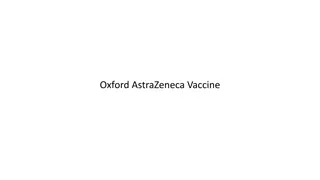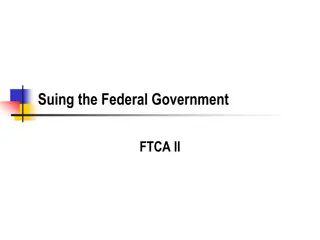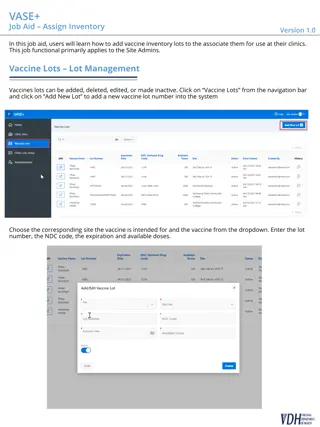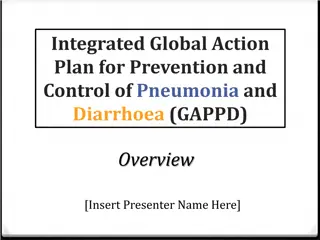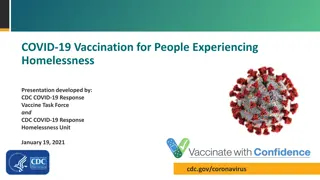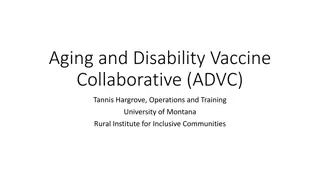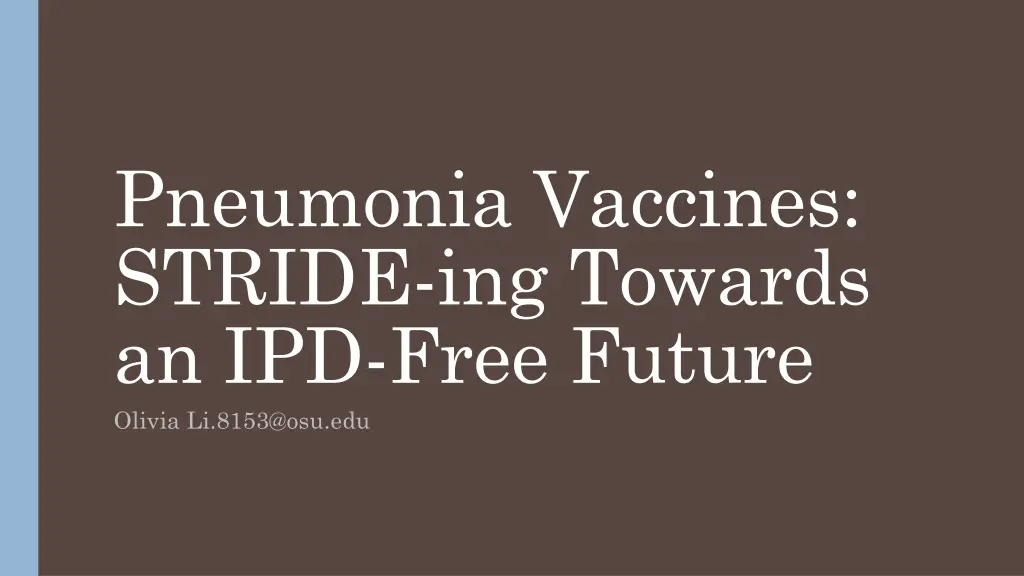
Understanding Pneumonia Vaccines: STRIDE-ing Towards an IPD-Free Future
Explore the world of pneumonia vaccines, including how Streptococcus pneumoniae causes diseases and the benefits and drawbacks of different pneumonia vaccines. Learn about the latest vaccines like Prenar 20 and Capvaxive, and evaluate studies used in the approval process. Dive into the prevention of pneumococcal disease through pneumococcal polysaccharide and conjugate vaccines, and understand their effectiveness in various age groups. Stay informed about the ongoing efforts to create an IPD-free future with advanced vaccination strategies.
Download Presentation

Please find below an Image/Link to download the presentation.
The content on the website is provided AS IS for your information and personal use only. It may not be sold, licensed, or shared on other websites without obtaining consent from the author. If you encounter any issues during the download, it is possible that the publisher has removed the file from their server.
You are allowed to download the files provided on this website for personal or commercial use, subject to the condition that they are used lawfully. All files are the property of their respective owners.
The content on the website is provided AS IS for your information and personal use only. It may not be sold, licensed, or shared on other websites without obtaining consent from the author.
E N D
Presentation Transcript
Pneumonia Vaccines: STRIDE-ing Towards an IPD-Free Future Olivia Li.8153@osu.edu
Objectives Understand how Streptococcus pneumoniae causes disease Identify the benefits and drawbacks of different pneumonia vaccines Explain the differences between Prenar 20 and Capvaxive, the latest pneumonia vaccine to be approved Evaluate 2 studies used in the approval of Capvaxive
Streptococcus pneumoniae Gram positive bacterium Non-invasive and invasive infections Pneumonia, otitis media Invasive pneumococcal disease (IPD), bacteremia Higher risk and mortality in both young children and older adults Over 100 serotypes discovered 23 serotypes responsible for 80-90% of invasive infections 10 most common serotypes cause 62% of invasive infections worldwide Nat Rev Microbiol. 2018;16(6):355-367. Vaccines (Basel). 2021;9(5):420. Dela J Public Health. 2022;8(1):36-38.
Pneumonia Vaccines Prevention of pneumococcal disease
Pneumococcal polysaccharide vaccine (PPV) PPSV14 PPSV23 (Pneumovax 23) Capsular polysaccharides Induce antibody response in 80% of adults Reduce incidence of IPD of included strains by 60-70% Waning antibody levels after 5 years Reduced response in immunocompromised patients No prevention to pneumococcal pneumonia Ineffective in children under 2 Vaccines (Basel). 2021;9(5):420. Dela J Public Health. 2022;8(1):36-38.
Pneumococcal conjugate vaccine (PCV) PCV20 (Prevnar 20) PCV15 (Vaxneuvance) PCV21 (Capvaxive) PCV7 (Prevnar) PCV10 (Synflorix) PCV13 (Prevnar 13) Capsular polysaccharides conjugated with a carrier protein Carrier protein can induce T-cell dependent immune response in adults and young children Childhood vaccination with PCV7 has demonstrated a 97% reduction of IPD in PCV7 strains and 20% reduction in pneumonia PCV13 vaccination in older adults reduced non-bacteremic pneumococcal pneumonia by 45% and IPD by 75% in PCV13 strains (CAPiTA) Vaccines (Basel). 2021;9(5):420. Dela J Public Health. 2022;8(1):36-38.
CDC Recommendations Infants, children PCV15 or PCV20 4 dose series at 2 months, 4 months, 6 months, 12-15 months Catch-up schedule for children under 5 years old Adults 50+ PCV20 or PCV21 Unvaccinated PCV15 1 year PPSV23 Unvaccinated PCV20 or PCV21 PPSV23 or PCV13 only 1 year 1 year PCV15 PPSV23 only PCV13 (any age) AND PPSV23 (< 65 years) PCV20 or PCV21 5 years https://www.cdc.gov/pneumococcal /hcp/vaccine- recommendations/index.html
PCV20 versus PCV21 Does covering 21 serotypes instead of 20 really make a difference?
Prevnar 20 (PCV20) Pfizer approved 2021 20 serotypes: 1, 3, 4, 5, 6A, 6B, 7F, 8, 9V, 10A, 11A, 12F, 14, 15B, 18C, 19A, 19F, 22F, 23F, and 33F Prevent IPD in patients 6+ weeks old Prevent otitis media in patients 6 weeks to 5 years old for serotypes 4, 6B, 9V, 14, 18C, 19F, and 23F Prevent pneumonia in patients 18+ years old Approval built on data from Prevnar and Prevnar 13 for same serotypes Approval for new serotypes based on opsonophagocytic activity (OPA) assay https://prevnar20.pfizerpro.com/ Prevnar 20 Package Insert. 2021.
Capvaxive (PCV21) Merck approved 2024 *15C antibodies elicited due to structural similarity to 15B (de-O- acetylated 15B) 21 serotypes: 3, 6A, 7F, 8, 9N, 10A, 11A, 12F, 15A, 15B, 15C*, 16F, 17F, 19A, 20A, 22F, 23A, 23B, 24F, 31, 33F, and 35B Prevent IPD in patients 18+ years for serotypes 3, 6A, 7F, 8, 9N, 10A, 11A, 12F, 15A, 15B, 15C, 16F, 17F, 19A, 20A, 22F, 23A, 23B, 24F Prevent pneumonia in patients 18+ years for serotypes 3, 6A, 7F, 8, 9N, 10A, 11A, 12F, 15A, 15C, 16F, 17F, 19A, 20A, 22F, 23A, 23B, 24F, 31, 33F, and 35B Approval based on opsonophagocytic activity (OPA) assay Higher incidence of IPD in adults than children, but not all serotypes covered in vaccines 8 serotypes unique to PCV21 caused 30% of IPD cases in 2019 covered by all PCV21 serotypes Capvaxive Package Insert. 2021. Lancet Infect Dis. 2024;24(10):1141-1150. https://www.merckvaccines.com/capvaxive/
STRIDE-3 Safety, tolerability, and immunogenicity of an adult pneumococcal conjugate vaccine, V116: a randomised, double-blind, active comparator controlled, international phase 3 trial Compare V116 (PCV21) to PCV20 in pneumococcal vaccine-na ve adults Inclusion criteria: no previous pneumococcal vaccine, with or without chronic stable medical conditions Exclusion criteria: history of culture-positive pneumococcal disease, immunocompromised, on immunosuppression Cohort 1 Cohort 2 Adults 50+ years 2,362 adults randomized 1:1 to receive 1 dose of V116 (1,181) or PCV20 (1181) Adults 18-49 years 301 adults randomized 2:1 to receive 1 dose of V116 (201) or PCV20 (100) Lancet Infect Dis. 2024;24(10):1141-1150.
STRIDE-3: Endpoints Immunogenicity endpoints Non-inferiority using serotype-specific OPA geometric mean titer ratios in cohort 1 for serotypes in both vaccines at day 30 Superiority using OPA geometric mean titer ratios in cohort 1 for serotypes unique to V116 Superiority defined by the proportion of participants in cohort 1 with at least a four- fold rise for serotypes unique to V116 day 1 to day 30 Non-inferiority in cohort 2 serotype-specific OPA geometric mean titer ratios compared to cohort 1 at day 30 ( immunobridging ) Secondary endpoints: evaluation of serotype-specific IgG geometric mean concentrations in cohort 1 at day 30 for all V116 serotypes, evaluation of serotype- specific cross-reactive immune responses 15B and 6C using OPA geometric mean titer ratios in cohort 1 at day 30, proportion of participants in cohort 1 with at least a four-fold rise in serotype-specific OPA and IgG responses from baseline to day 30 in cohort 1 Safety endpoints Injection-site reactions and systemic adverse events until day 5 Vaccine-related serious adverse events at any time Lancet Infect Dis. 2024;24(10):1141-1150.
STRIDE-3: Results Study population: most from US; ~50% in cohort 1 aged 65+ (both groups); more women; more white participants V116 non-inferior to PCV20 for all serotypes common to both vaccines V116 superior to PCV20 for all unique serotypes except 15C Immunobridging demonstrated in cohort 2 (efficacy in all adults) Overall safety profile similar to PCV20 and other PCVs PCV21 is a safe and efficacious option for adults for the prevention of IPD and pneumonia Major limitation: exclusion of patients previously vaccinated with a pneumonia vaccine Lancet Infect Dis. 2024;24(10):1141-1150.
STRIDE-6 A Study to Evaluate the Safety, Tolerability, and Immunogenicity of V116 in Pneumococcal Vaccine-experienced Adults Compare V116 (PCV21) to PCV15 and PPSV23 in adults 50+ who have already received at least 1 pneumococcal vaccine at least 1 year prior Exclusion criteria: history of IPD or culture-positive pneumococcal disease within 3 years of start of study, immunosuppressive therapy, received PPSV23 followed by PCV15 or PCV20 prior to study enrollment Cohort 1 Cohort 2 Cohort 3 (open label) Received PPSV23 1+ year prior to study enrollment 350 adults randomized 2:1 to receive V116 (231) or PCV15 (119) Received PCV13 1+ year prior to study enrollment 261 adults randomized 2:1 to receive V116 (176) or PPSV23 (85) Received PCV13 + PPSV23, PCV15 + PPSV23, PCV15, PCV20, or PPSV23 + PCV13 1+ year prior to study enrollment 106 adults received V116 Clin Infect Dis. doi:10.1093/cid/ciae383
STRIDE-6: Endpoints Immunogenicity endpoints Evaluate serotype-specific OPA geometric mean titers at day 30 in all cohorts Secondary endpoints: serotype-specific IgG geometric mean concentrations, geometric mean fold rise + proportion of participants with at least a four-fold rise in serotype-specific antibodies day 1 to day 30 Safety endpoints Max daily temperature, injection-site reactions, and systemic adverse events until day 5 Other adverse events until day 30 Serious adverse events and deaths at any time Clin Infect Dis. doi:10.1093/cid/ciae383
STRIDE-6: Results Study population: ~70% of participants at 65+; more women; more white; ~47% had a medical condition that increased risk for pneumococcal disease All 21 serotypes in V116 induced an immune response Immunogenicity comparable for both vaccines in cohort 1 and both vaccines in cohort 2 for common serotypes and higher for V116 unique serotypes Adverse events comparable across all cohorts Covers an additional 32% of IPD compared to PCV20 Safe and effective for use after immunization with other pneumococcal vaccines Clin Infect Dis. doi:10.1093/cid/ciae383
Conclusions Capvaxive (PCV21) is a safe and effective pneumococcal vaccine to vaccinate adults over the age of 50 years old A CAPiTA-like study is needed to assess real-world protection Further studies needed to determine any benefit of PCV21 vaccination after PCV20 High risk patients should receive whatever vaccine is available as soon as possible, while lower risk patients can wait until they are able to receive PCV21
References Weiser JN, Ferreira DM, Paton JC. Streptococcus pneumoniae: transmission, colonization and invasion. Nat Rev Microbiol. 2018;16(6):355-367. doi:10.1038/s41579-018-0001-8 Scelfo C, Menzella F, Fontana M, Ghidoni G, Galeone C, Facciolongo NC. Pneumonia and Invasive Pneumococcal Diseases: The Role of Pneumococcal Conjugate Vaccine in the Era of Multi-Drug Resistance. Vaccines (Basel). 2021;9(5):420. Published 2021 Apr 22. doi:10.3390/vaccines9050420 O'Neill JH Jr. Pneumococcal Immunization for Adults in 2022. Dela J Public Health. 2022;8(1):36-38. Published 2022 Mar 29. doi:10.32481/djph.2022.03.006 Pneumococcal vaccine recommendations. Centers for Disease Control and Prevention. October 26, 2024. https://www.cdc.gov/pneumococcal/hcp/vaccine-recommendations/index.html. Prevnar 20. Package insert. Pfizer; 2021. Capvaxive. Package insert. Merck & Co., Inc; 2024. Platt HL, Bruno C, Buntinx E, et al. Safety, tolerability, and immunogenicity of an adult pneumococcal conjugate vaccine, V116 (STRIDE-3): a randomised, double-blind, active comparator controlled, international phase 3 trial. Lancet Infect Dis. 2024;24(10):1141-1150. doi:10.1016/S1473-3099(24)00344-X Scott P, Haranaka M, Choi JH, et al. A Phase 3 Clinical Study to Evaluate the Safety, Tolerability, and Immunogenicity of V116 in Pneumococcal Vaccine-Experienced Adults 50 Years of Age or Older (Stride- 6). Clin Infect Dis. Published online July 31, 2024. doi:10.1093/cid/ciae383



